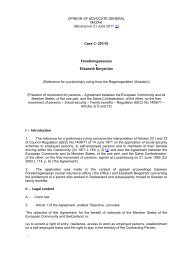Study on non-legislative initiatives for companies to promote gender ...
Study on non-legislative initiatives for companies to promote gender ...
Study on non-legislative initiatives for companies to promote gender ...
Create successful ePaper yourself
Turn your PDF publications into a flip-book with our unique Google optimized e-Paper software.
Gender equality <strong>initiatives</strong> 7<br />
behavioural patterns of men and women) and <strong>to</strong> comprehensive career development<br />
programmes as well as systems <strong>to</strong> ensure equal pay. Besides having a reporting<br />
system and m<strong>on</strong>i<strong>to</strong>ring the figures, the <strong>companies</strong> analysed find it crucial <strong>to</strong> detect and<br />
understand the reas<strong>on</strong>s behind career breaks of women in order <strong>to</strong> react adequately<br />
and elaborate targeted <strong>initiatives</strong>.<br />
Training: Enterprises often use training <strong>on</strong> diversity and inclusi<strong>on</strong> issues (that also<br />
includes <strong>gender</strong> equality) <strong>to</strong> familiarise new employees with the company’s diversity<br />
culture. Specific training <strong>on</strong> <strong>gender</strong> issues <strong>for</strong> managers may help <strong>to</strong> become c<strong>on</strong>scious<br />
of pers<strong>on</strong>al biases and develop strategies <strong>to</strong> overcome these. Many of the more comprehensive<br />
<strong>initiatives</strong> <strong>to</strong> enable <strong>gender</strong> equality in a company include such trainings.<br />
There are also measures that can be used in other fields of training, i. e. <strong>to</strong> provide<br />
training in a way that is supportive <strong>to</strong> <strong>gender</strong> equality. Some of the enterprises analysed<br />
in this study have set minimum training targets <strong>for</strong> all their employees or make sure that<br />
their trainee programmes have a fairly good distributi<strong>on</strong> of men and women.<br />
It has been noted by the <strong>companies</strong> that training is often designed in a way that<br />
appears <strong>to</strong> suit men more than women. Am<strong>on</strong>g the measures <strong>to</strong> design a training<br />
that also accounts <strong>for</strong> the exigencies of women are e. g. c<strong>on</strong>sidering both “male” and<br />
“female” learning patterns, c<strong>on</strong>sidering male and female trainers as well as determining<br />
appropriate training mode, time and learning envir<strong>on</strong>ment. Training is also used <strong>to</strong><br />
<strong>promote</strong> <strong>gender</strong> equality in other fields of interventi<strong>on</strong>, e. g. women specific training in<br />
career development.<br />
Networks: While in most <strong>companies</strong> internal networks of women, respectively of<br />
women and men, have emerged <strong>to</strong> serve the purpose of <strong>gender</strong> equality, there are also<br />
examples of <strong>companies</strong> that start networking activities <strong>for</strong> women by participating in<br />
external women’s networks.<br />
There are mainly networking approaches that c<strong>on</strong>centrate <strong>on</strong> a certain hierarchical<br />
level (e. g. <strong>on</strong> women in management respectively men and women in management<br />
supporting <strong>gender</strong> equality), but networks that allow <strong>for</strong> membership from any<br />
hierarchical level could also be identified.<br />
Networks often act as drivers <strong>for</strong> the development of new strategies <strong>to</strong> <strong>promote</strong><br />
<strong>gender</strong> equality, they have proven very useful <strong>to</strong> raise and share in<strong>for</strong>mati<strong>on</strong> am<strong>on</strong>g<br />
members (e. g. about fields that require acti<strong>on</strong>), discuss priorities and develop acti<strong>on</strong><br />
plans. Some rather powerful company internal women networks are described in this<br />
study. Networking may also be applied as means <strong>to</strong> support career progressi<strong>on</strong> of<br />
women, e. g. when different hierarchical levels are brought <strong>to</strong>gether. Several<br />
men<strong>to</strong>ring programmes follow this approach.<br />
Communicati<strong>on</strong>: Clear and c<strong>on</strong>cise internal and external communicati<strong>on</strong> about an<br />
enterprise’s <strong>gender</strong> equality approach (in general within the corporate diversity and<br />
inclusi<strong>on</strong> policy) is crucial <strong>to</strong> impart a reliable and sustainable picture of a <strong>companies</strong>’<br />
corporate identity and values. Am<strong>on</strong>g the measures <strong>to</strong> support this are e. g. written<br />
statements by the Board that show the commitment <strong>to</strong> the issue (the identificati<strong>on</strong> of<br />
the <strong>to</strong>p level with the issue is crucial) but also internal Codes of C<strong>on</strong>duct or Agreements<br />
with external parties (such as uni<strong>on</strong>s). In this c<strong>on</strong>text, many <strong>companies</strong> have also<br />
become more <strong>gender</strong> sensitive <strong>to</strong>wards their external appearance (and their<br />
advertising).
















